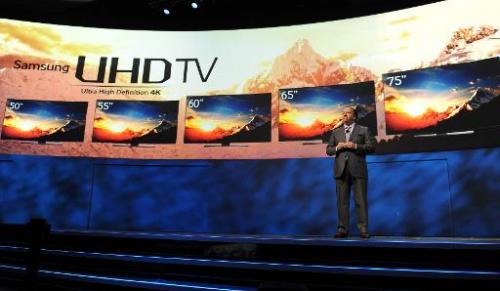Television giants at the Consumer Electronics Show in Las Vegas are touting the wonders of ultra high-definition screens despite doubts by analysts that people will buy them.
Screens offering picture resolution about four times more vivid than current high-definition sets starred at an array of press events staged on the eve of the CES showfloor opening on Tuesday.
Japanese entertainment and consumer electronics titan Sony made Ultra HD, also referred to as 4K, sets and matching content the centerpiece of a presentation that ran a gamut of gadgets.
"I can't stop talking about 4K," said Sony Electronics chief operating officer Mike Fasulo.
"I tell everyone it is like looking out a window."
Sony unveiled new cameras for capturing video in 4K as well as screens designed to display the rich footage in all its glory.
"But we all know that content is king," Fasulo said. "We have made significant advances there as well."
Sony's Video Unlimited service boasts a library of more than 140 titles, including the full catalogue of the hit series "Breaking Bad."
Sony is also working with Google-owned YouTube and popular online video streaming service Netflix to feature 4K content on television sets.
The Internet is the "natural medium to deliver 4K" shows or films to televisions, Netflix chief executive Reed Hastings said during an appearance at the Sony presentation.
"It's a chance for the Internet to really shine," Hastings said.
"Creators are very excited about 4K and what it allows them to show in storytelling."
Sony also makes professional cameras for shooting films or television shows in 4K resolution.

Samsung Electronics America Executive Vice President Joe Stinziano speaks at the Samsung press event at the Mandalay Bay Convention Center for the 2014 International CES on January 6, 2014 in Las Vegas, Nevada
4K refers to horizontal resolution on the order of 4,000 pixels boasted by new-generation televisions. Current-generation high definition screens, comparatively, have pixel density of 1,080.
"Creation of 4K content is on the rise," Fasulo declared.
South Korean consumer electronics giant Samsung earlier on Monday showed off a "jaw-dropping" ultra high-definition television with a 105-inch, curved screen.
"It is a massive screen, and curved for a truly cinematic experience," Samsung Electronics America executive vice president Joe Stinziano said while unveiling what he billed as the world's largest curved U-HD television.
"Ultra-HD is going to drive the next change in the television industry."
Samsung also introduced a striking "Bendable TV" that can be converted from flat to curved screen with the touch of a button.
Stinziano said Samsung has 4K content partnerships with Netflix and Amazon, as well as film studios Paramount and 20th Century Fox.
Another South Korean consumer electronics powerhouse, LG, also weighed in with Ultra-HD televisions that featured curved screens.
Also among new LG television models was one with a frame to display art or personal photographs while screens are not in use.
LG announced an alliance with Netflix to stream 4K shows including "House of Cards" starring Kevin Spacey to new televisions.
But analysts remain skeptical that 4K will be enough to convince people to spend thousands of dollars to replace their current high-definition flat-screen televisions.
"TV makers are primed to be disappointed because the most important thing that will happen in TV in 2014 will be the continued expansion of online video into the TV screen via over-the-top solutions like the Xbox One, Roku, and Google's Chromecast," said Forrester analyst James McQuivey.
"Instead of raising the quality and cost bar like 4K does, these over-the-top devices and services lower consumer costs while expanding viewing options."
Roku technology is also being built into televisions.
Streaming rich 4K data smoothly requires high-capacity broadband connections, which can be costly or unavailable.
"Ultra HD is clearly the next big thing, but vendors are hoping it won't be like the last big thing—3-D TV—which went nowhere," said Avi Greengart, research director for consumer products at Current Analysis.
"TV manufacturers have tried gimmicks to get people to replace TVs, but people don't think there is anything wrong with the ones they have."
Meanwhile, Dolby has developed technology that lets film or television show makers create more visually stunning content that can be displayed over televisions most people already own.
"While we are in this big debate about more pixels, we think the real opportunity is in making them better," Dolby director of technology Pat Griffis said while demonstrating Dolby Vision at a CES event.
"Some television makers are using this to leap over those drinking the 4K Kool-Aid."
He quickly noted that Dolby Vision could be the "icing on the 4K cake," with viewers benefitting from both.





